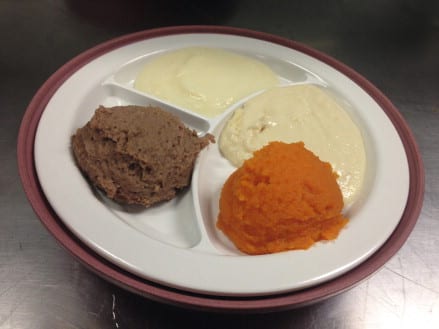
I recently finished a meals review of a residential care facility where 60% of the residents required texture modification of their meals.
I am seeing the dilemma – and the opportunity – of catering to this large cohort of people on texture modified diets, in residential care and in the community.
Staff at this busy facility (like many I immerse with), plate the food in the dining room.
Texture modified components are brought from the kitchen in small containers, one container for each component of each texture.
I often see 12 containers of texture modified components for each dining room – meat and 3 veg times 3 textures – plus gravy/sauce.
Staff are given scoops for portion control, and place a scoop of each on each plate, and top with the gravy/sauce.
Each well blended component is a uniform colour, sometimes resembling the component, often a dull grey, depending on the amount of time cooked, reheated and held hot.
Over the past 2 years I have seen the rise and rise of food components that are moulded into the shape of the food item.
Is this the answer?
After all, “we first eat with our eyes”.
The issues I see from the consumer’s perspective, when I sit and share meals with them, are 5-fold. Lets look at carrots as an example.
Moulding the food – This is a complex, highly skilled task. Carrots are cooked and pureed, thickener and liquid are added, heated, then put into a mould. It requires precision measuring to ensure the right texture for each texture level. Some thickeners and additives require heating, requiring temperature control. Then moulded and kept at a safe temperature, either frozen, refrigerated or hot until consumed. This preparation can radically change the taste of the food, even if it looks like a carrot. Extra additives dilute the taste of the original food. Additionally, some facilities have a policy of little or no salt or seasoning in the cooking process.
Reheating – Due to the extra handling involved with preparation, there is an increased potential for cross contamination. Cases of food-borne illness have been attributed to hygiene failure during this process. Food authorities recommend foods should be reheated to 70°C for 2 minutes (or equivalent) prior to serving. I have seen texture modified components placed in a combi oven for reheating for up to 60 minutes. Hot and extended reheating can result in overcooked, murdered carrots and changes the colour away from an eye-popping bright orange. If the meal is reheated in the dining room, staff may give it a zap in the microwave for 5 minutes on high, just to make sure it is hot, safe and reaches temperature.
Hot holding – If the texture modified meal is reheated in the main kitchen, it is then held hot (above 60°C) until being served. I have seen instances of hot holding for an extended time, up to 60 minutes, at temperatures up to 95°C recorded on the Food Safety Program form. The carrot colour is nudging towards a dull grey and the delicate moulded carrot has a skin on top and crusty/dried out around the edges.
Extra moistness – Staff are told that those on texture modification require extra sauce/gravy for moistness to aid in swallowing. So instant powdered gravy or white sauce is often the thickened liquid of choice. This can dilute and mask the taste of the food even more. There is also a sense of sameness, no matter what the meal.
Resident satisfaction – When onsite, I see high waste of the texture modified meal, whether moulded or not. What is produced in the kitchen often looks radically different by the time the resident receives it. Components take on a vague shape, are grey, dried out with a skin on top, smothered in gravy. If the meal takes a while to eat, it is consumed cool or cold, changing the texture to gluggy.
I have seen some gorgeous photos of amazing looking, exquisite texture modified meals on LinkedIn, Insta and blogs.
Well done to the creators, whether internal at a facility or an external specialised production site. My challenge is to have the meal looking that way at the time the resident receives it and is ready to eat.
It can be done but requires training, time, thoughtfulness, an understanding of the processes and implications and specialised equipment used properly.
Moulding is important, but is not the total solution. It should not even be attempted unless there is a deep understanding of the process and support from management to provide time and resources.
I also recommend staff get creative with presentation of non-moulded components. Keep cooking, reheating and hot holding to a minimum to maintain maximum colour and taste.
Season well and add butter, cream and other tasty nutritious options to ensure the right texture.
Pure food, brightly coloured, that smells and tastes delicious will go a long way with increasing consumption and satisfaction. Discussion about the meal and photos of the components can aid with memory and guide the eater.
Do you set your staff up to succeed with this increasingly vital and challenging task?
Image: ScienceDirect.